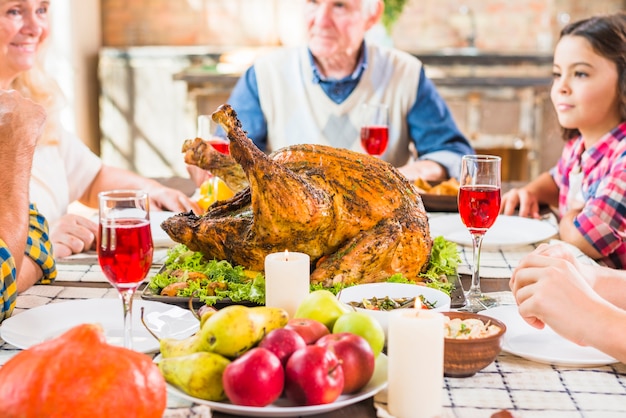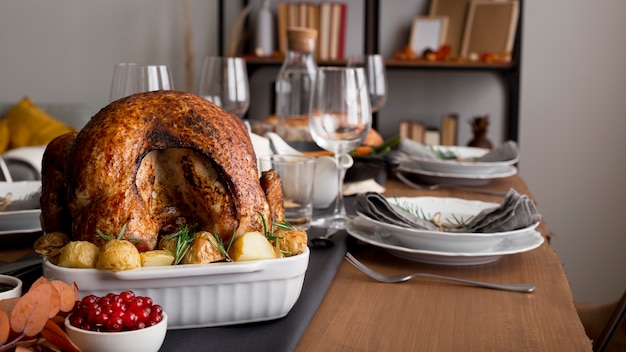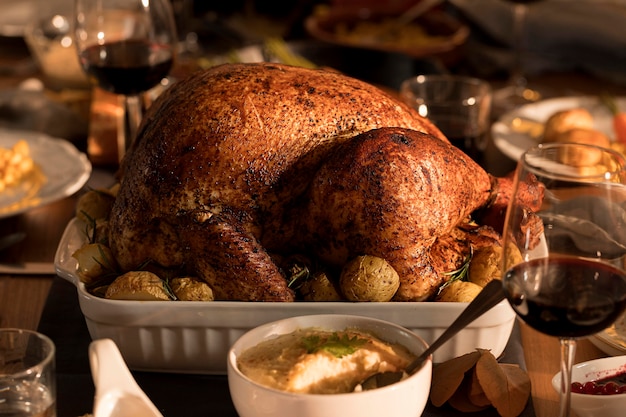Ah, the humble turkey. It’s the undisputed star of the festive table, a symbol of family gatherings and shared meals. But getting that bird cooked to perfection can be a bit of a culinary puzzle, especially when it comes to figuring out the right cooking time. You wouldn't want to end up with a dry, overcooked turkey, would you? No, no, we want a juicy, flavorful masterpiece that everyone will be clamouring for seconds of!
Well, fear not, my fellow turkey enthusiasts, for I'm here to guide you through the intricacies of turkey cooking time, ensuring a delicious triumph. I've spent years in the kitchen (okay, maybe not years, but definitely several festive seasons) honing my turkey-cooking skills, learning from both successes and, let's be honest, a few disastrous mishaps. Now, I'm ready to share my knowledge and wisdom to help you become a turkey-roasting champion.
(Part 1) The Anatomy of a Turkey

Before we dive into the specifics of cooking time, let's take a moment to understand the turkey itself. Imagine it as a puzzle – we need to know each piece to get the whole picture.
The Importance of Weight
The weight of your turkey is the first piece of our puzzle. It's like the foundation of a house – it dictates how much time you'll need to spend building that perfect bird. You can't just guesstimate and hope for the best! Think of it like this – a small turkey, say around 10 pounds, is like a cozy cottage, while a 20-pound turkey is more akin to a grand mansion. Naturally, a grand mansion takes longer to build than a cosy cottage, right? It's the same with your turkey - the bigger the bird, the longer the cooking time.
The Role of Stuffing
Next up, we have the stuffing. This is like the décor of your turkey house. If you’re a stuffing enthusiast, remember that it adds to the cooking time. Stuffing absorbs moisture and needs time to cook thoroughly, so it's like adding an extra room to your mansion, requiring more time to build.
(Part 2) The Science of Cooking Time

Okay, so we've identified the key components – the weight and stuffing. Now, let's get down to the science of cooking time.
unstuffed turkey cooking time
For an unstuffed turkey, a good rule of thumb is to allow 13 to 15 minutes per pound of turkey. So, if you have a 12-pound turkey, you'll need to cook it for about 156 to 180 minutes (2.5 to 3 hours) at 350 degrees Fahrenheit.
The Impact of Stuffing
As we discussed earlier, stuffing adds an extra layer to the cooking process. To ensure the stuffing cooks thoroughly and the turkey reaches an internal temperature of 165 degrees Fahrenheit, you'll need to add an additional 30 minutes to your total cooking time. So, our 12-pound turkey with stuffing would require 186 to 210 minutes (3.1 to 3.5 hours) of cooking time.
(Part 3) Temperature: The Secret Ingredient

We've nailed down the basics of weight and stuffing, but there's one more crucial ingredient in our turkey-roasting recipe: temperature. Just like a baker needs the perfect oven temperature for a delicious cake, we need the right temperature for a perfectly cooked turkey.
Why 350 Degrees Fahrenheit?
350 degrees Fahrenheit is a tried-and-true temperature for roasting turkey. It's like the sweet spot for cooking – high enough to ensure thorough cooking but not so high that it dries out the meat. It allows the turkey to cook evenly, creating that beautiful golden-brown crust and juicy interior.
The Importance of Oven Accuracy
Now, here’s a little secret – ovens can be tricky! They don’t always run at the temperature they say they do. That’s where an oven thermometer comes in handy. It’s a small investment that can save you a lot of frustration. Think of it as a double-check on your oven's accuracy, ensuring that your turkey cooks perfectly.
(Part 4) Prepping for Success: The Turkey Makeover
Your turkey is ready to go, but before it hits the oven, there are a few prep steps to ensure a delightful result.
Brining: The Moisture Boost
Brining is like giving your turkey a spa treatment before the big day. It’s a simple but effective technique that involves soaking your turkey in a salt and water solution for several hours or overnight. The salt draws out moisture from the meat and then pulls it back in, creating incredibly moist and tender turkey. Trust me, it’s worth the extra effort!
Patting It Dry: A Crucial Step
After the brine bath, pat your turkey dry with paper towels. This is like drying off after a swim – it helps the skin get nice and crispy in the oven.
Seasoning: Adding Flavor
Now, it's time to add those flavourful touches. Salt and pepper are essential, but feel free to experiment with your favourite herbs and spices. A touch of paprika, garlic powder, or even a sprinkle of rosemary can add depth to your turkey's flavour profile.
Stuffing: The Debate Continues
Stuffing is a classic addition, but it’s a matter of personal preference. If you decide to stuff your turkey, be sure to follow these tips:
- Don't Overstuff: Leave some space for the stuffing to cook evenly.
- Cook Separately: For safety, cook your stuffing separately in a baking dish, ensuring it reaches an internal temperature of 165 degrees Fahrenheit.
- Meat-based Stuffing: If you’re using a meat-based stuffing, cook it to an internal temperature of 165 degrees Fahrenheit.
Roasting: Time to Shine
Your turkey is prepped and ready for the oven! Place it on a roasting rack in a large roasting pan. This allows air to circulate around the bird, promoting even cooking.
Basting: A Touch of Moisture
Basting is like a little mid-cooking pampering. It involves spooning pan juices over the bird, keeping the skin moist and adding extra flavour. Start basting after the first hour of cooking.
(Part 5) The Importance of Temperature Monitoring
We've got our turkey in the oven, but how do we know when it's ready? That’s where temperature monitoring comes in.
The Internal Temperature Test
The best way to check the turkey's internal temperature is with a meat thermometer. Insert the thermometer into the thickest part of the thigh, making sure it doesn’t touch any bones. You want to achieve an internal temperature of 165 degrees Fahrenheit.
Understanding Doneness
When the turkey reaches 165 degrees Fahrenheit, it’s fully cooked and ready to carve. Don’t worry, even if you reach the target temperature before the recommended cooking time, you can take it out of the oven.
(Part 6) The Art of turkey carving
The turkey is cooked, resting, and ready to be carved. This is the moment of truth, the culmination of your efforts.
Essential Tools
You'll need a sharp carving knife and a cutting board. A sharp knife makes the process easier and ensures even slices.
The Carving Process
Start by removing the legs and thighs by cutting along the joint between the thigh and the body. Next, cut the breast into slices, cutting against the grain of the meat for tender, juicy slices.
(Part 7) Leftovers: A Culinary Treasure Trove
You’ve cooked a beautiful turkey, and you’ve carved it with finesse. But wait, there’s still a mountain of leftovers! Don’t despair! turkey leftovers are a culinary treasure trove, opening up a world of delicious possibilities.
Creative Leftover Ideas
Here are a few ideas to get your creative juices flowing:
- turkey pot pie: A comforting and satisfying dish that’s perfect for a chilly evening.
- turkey soup: A hearty and flavorful soup that’s perfect for a cold day.
- turkey salad: A light and refreshing salad that’s perfect for lunch.
- Turkey chili: A spicy and flavorful chili that’s perfect for a chilly evening.
- Turkey enchiladas: A delicious and easy meal that’s perfect for a busy weeknight.
(Part 8) FAQs: Addressing Your Turkey Queries
1. Can I stuff my turkey the day before?
It’s not recommended to stuff your turkey the day before. The stuffing will absorb moisture from the turkey, making it soggy and less flavorful. It’s best to stuff your turkey just before roasting to ensure it stays moist and flavorful.
2. How do I know if my turkey is cooked through?
The best way to check if your turkey is cooked through is to use a meat thermometer. Insert the thermometer into the thickest part of the thigh, making sure it doesn’t touch any bones. The internal temperature should reach 165 degrees Fahrenheit.
3. Can I freeze my turkey leftovers?
Yes, you can freeze your turkey leftovers. It’s best to store them in airtight containers or freezer bags. Leftover turkey will keep in the freezer for 2 to 3 months.
4. What’s the best way to reheat turkey leftovers?
The best way to reheat turkey leftovers is in the oven. Preheat your oven to 350 degrees Fahrenheit and place the leftover turkey in a baking dish. Heat for 15 to 20 minutes, or until warmed through.
5. What should I do if my turkey is dry?
If your turkey is dry, there are a few things you can do:
- Add some gravy: A generous dollop of gravy can help to moisten the turkey.
- Make a turkey salad: You can make a turkey salad with mayonnaise, celery, and onion.
- Add some cheese: You can add some cheese to your turkey leftovers for extra flavor and moisture.
And there you have it! My ultimate guide to turkey cooking time at 350 degrees Fahrenheit. Now you’re equipped with the knowledge to cook a juicy, flavorful turkey that everyone will be raving about. Remember, practice makes perfect, so don’t be afraid to experiment. And most importantly, enjoy the process!
Everyone is watching

Corn on the Cob: The Ultimate Guide to Perfectly Cooked Ears
Healthy MealsAh, corn on the cob. Just the name evokes images of sunny days, barbecues, and that sweet, juicy flavour that ...

Perfect Pork Roast Oven Cooking Time: A Guide to Delicious Results
Healthy MealsThere's something truly satisfying about a perfectly roasted pork. The aroma alone is enough to make your mout...

Ham Cooking Time: How Long to Bake, Smoke, or Boil a Delicious Ham
Healthy MealsAh, ham. It's a classic, isn't it? A real crowd-pleaser, especially around holidays. And when done right, it'...

Scallops: The Ultimate Guide to Perfect Cooking
Healthy MealsAh, scallops. Those delicate, sweet, and utterly delicious morsels of the sea. They hold a special place in my...

Spaghetti Squash: The Ultimate Guide to Cooking and Serving
Healthy MealsRemember that time you saw spaghetti squash at the supermarket, looking all bumpy and strange, and thought, "W...
